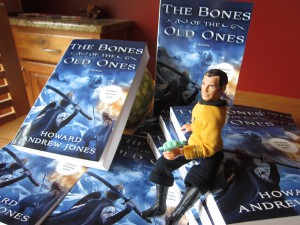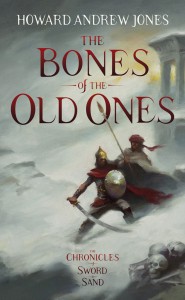Novel Lessons 3: The Bones of the Old Ones
 Three weeks ago I mentioned that it had taken me a year, writing in my spare time, to create the first Dabir and Asim novel, The Desert of Souls. Well, when it came to its sequel, it took just as long, even though I was writing full time. Sadly, it proved one of the most challenging books I’ve yet written, even though up until the most recent, unpublished novel, For The Killing of Kings, it was my favorite and the one of which I was most proud.
Three weeks ago I mentioned that it had taken me a year, writing in my spare time, to create the first Dabir and Asim novel, The Desert of Souls. Well, when it came to its sequel, it took just as long, even though I was writing full time. Sadly, it proved one of the most challenging books I’ve yet written, even though up until the most recent, unpublished novel, For The Killing of Kings, it was my favorite and the one of which I was most proud.
What went wrong? Well, that’s where the lessons come in.
First, I thought that my skeletal outline method was the way to go. It turns out that worked just fine for the first book, which was an origin story. I wanted to do something more complex with the second book now that my main characters were brothers in all but blood, and a wiser man than me should have realized that meant he needed a more complicated outline. I sure wish I could talk to that guy, because he would have saved himself and his poor, long suffering wife a whole lot of anguish.
You see, I ended up writing The Bones of the Old Ones no less than three times from almost start to finish. That certainly wasn’t my intent. Nearly everything about the plot changed apart from the general concept and the first three or four chapters. I had a strong beginning scene, but I cut it early on, and it took my wife and my editor, Pete Wolverton, some serious convincing to get me back to that start when I began it the third time.
Second, I only had a vague idea about my villains. I THOUGHT I knew them better than I did, but I was so eager to get started that I hadn’t thought them through very clearly. As a result I didn’t completely know their powers, or even their motivations. That was, frankly, an idiot move, because the middle got really muddy when I didn’t have an idea how the bad guys would be reacting to what was happening.
 Third, I had plenty of cool characters but I wasn’t utilizing them enough. I didn’t realize until I was writing a rough of the cover copy for the publisher to use for marketing purposes that I could tighten the narrative and introduce one of the villains as an ongoing threat. In writing cover copy you’re generating what’s supposed to sound like a thrilling synopsis, and as I did so I suddenly understood that my plot wasn’t actually that thrilling for the first third. The characters needed more of an ongoing threat in the opening sections of the story. I changed the structure again, added some scenes, and strengthened the tale.
Third, I had plenty of cool characters but I wasn’t utilizing them enough. I didn’t realize until I was writing a rough of the cover copy for the publisher to use for marketing purposes that I could tighten the narrative and introduce one of the villains as an ongoing threat. In writing cover copy you’re generating what’s supposed to sound like a thrilling synopsis, and as I did so I suddenly understood that my plot wasn’t actually that thrilling for the first third. The characters needed more of an ongoing threat in the opening sections of the story. I changed the structure again, added some scenes, and strengthened the tale.
Each character needs to be doing interesting things. Shakespeare showed us this. Every one of his characters was portrayed by an actor, and so he tended to imbue all of them, even if they’re just walking on to kill a king for one scene, with a little bit of personality. That way each actor can have a moment. In part I’m sure that was so his company of actors would all enjoy their parts, but that’s also because it so much more interesting to see characters doing interesting things.
Fourth, I learned to start sharing my ideas and drafts with a trusted group of readers a little sooner. At least, I SHOULD have learned that. I told my wife I would after she had some brilliant feedback for me very late in the game to fix the ending (with some strong assistance from my agent, Bob Mecoy). If I’d talked things through with those I trust I could have saved myself a lot of pain. I thought I’d learned that lesson, but it was a mistake I’d repeat, even if it was to a slightly lesser extent, in future drafts. That stemmed from my own stubbornness in wanting to be self sufficient.
I don’t think you can tell what a pain in the butt that book was to write. The end result still makes me happy, although its a bittersweet joy. With their origin out of the way, Dabir and Asim could get on to weird and exciting and complicated adventures, and I had big plans for them. Alas, even with a starred review from Publisher’s Weekly, it didn’t sell very well. I was wrestling away with the third novel when the sales figures showed my editor and me that the writing was on the wall. Some day I want to at least finish that third Dabir and Asim and get it out there, probably self published, and I sometimes dream of finishing the whole series I had planned, but I suppose that will depend upon how much interest there is when I sell the third.
But that will have to wait until I get a new series going that will hopefully be much more successful, and then those readers will, also hopefully, be interested in reading my other work.
Next week I’ll take a look at my second Pathfinder novel, which I drafted during the months before Bones of the Old Ones was released.
2 Comments